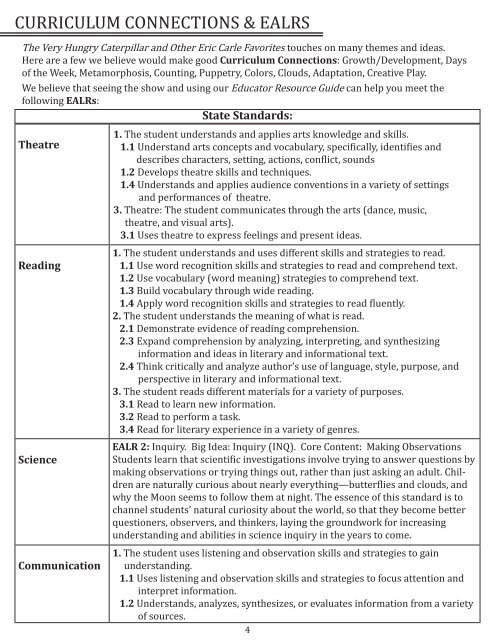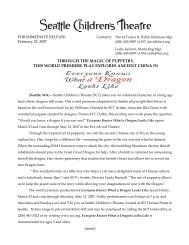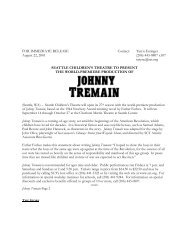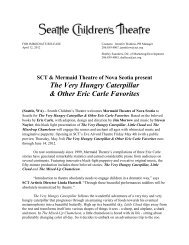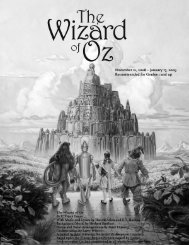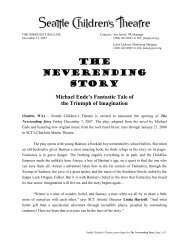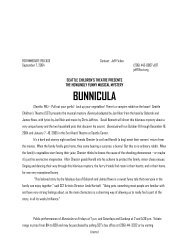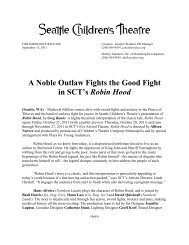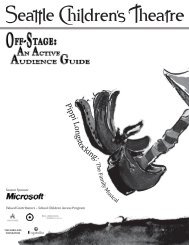The Very Hungry Caterpillar ERG - Seattle Children's Theatre
The Very Hungry Caterpillar ERG - Seattle Children's Theatre
The Very Hungry Caterpillar ERG - Seattle Children's Theatre
You also want an ePaper? Increase the reach of your titles
YUMPU automatically turns print PDFs into web optimized ePapers that Google loves.
CURRICULUM CONNECTIONS & EALRS<br />
<strong>The</strong> <strong>Very</strong> <strong>Hungry</strong> <strong>Caterpillar</strong> and Other Eric Carle Favorites touches on many themes and ideas.<br />
Here are a few we believe would make good Curriculum Connections: Growth/Development, Days<br />
of the Week, Metamorphosis, Counting, Puppetry, Colors, Clouds, Adaptation, Creative Play.<br />
We believe that seeing the show and using our Educator Resource Guide can help you meet the<br />
following EALRs:<br />
State Standards:<br />
<strong>The</strong>atre<br />
Reading<br />
Science<br />
Communication<br />
1. <strong>The</strong> student understands and applies arts knowledge and skills.<br />
1.1 Understand arts concepts and vocabulary, specifically, identifies and<br />
describes characters, setting, actions, conflict, sounds<br />
1.2 Develops theatre skills and techniques.<br />
1.4 Understands and applies audience conventions in a variety of settings<br />
and performances of theatre.<br />
3. <strong>The</strong>atre: <strong>The</strong> student communicates through the arts (dance, music,<br />
theatre, and visual arts).<br />
3.1 Uses theatre to express feelings and present ideas.<br />
1. <strong>The</strong> student understands and uses different skills and strategies to read.<br />
1.1 Use word recognition skills and strategies to read and comprehend text.<br />
1.2 Use vocabulary (word meaning) strategies to comprehend text.<br />
1.3 Build vocabulary through wide reading.<br />
1.4 Apply word recognition skills and strategies to read fluently.<br />
2. <strong>The</strong> student understands the meaning of what is read.<br />
2.1 Demonstrate evidence of reading comprehension.<br />
2.3 Expand comprehension by analyzing, interpreting, and synthesizing<br />
information and ideas in literary and informational text.<br />
2.4 Think critically and analyze author’s use of language, style, purpose, and<br />
perspective in literary and informational text.<br />
3. <strong>The</strong> student reads different materials for a variety of purposes.<br />
3.1 Read to learn new information.<br />
3.2 Read to perform a task.<br />
3.4 Read for literary experience in a variety of genres.<br />
EALR 2: Inquiry. Big Idea: Inquiry (INQ). Core Content: Making Observations<br />
Students learn that scientific investigations involve trying to answer questions by<br />
making observations or trying things out, rather than just asking an adult. Children<br />
are naturally curious about nearly everything—butterflies and clouds, and<br />
why the Moon seems to follow them at night. <strong>The</strong> essence of this standard is to<br />
channel students’ natural curiosity about the world, so that they become better<br />
questioners, observers, and thinkers, laying the groundwork for increasing<br />
understanding and abilities in science inquiry in the years to come.<br />
1. <strong>The</strong> student uses listening and observation skills and strategies to gain<br />
understanding.<br />
1.1 Uses listening and observation skills and strategies to focus attention and<br />
interpret information.<br />
1.2 Understands, analyzes, synthesizes, or evaluates information from a variety<br />
of sources.<br />
4


